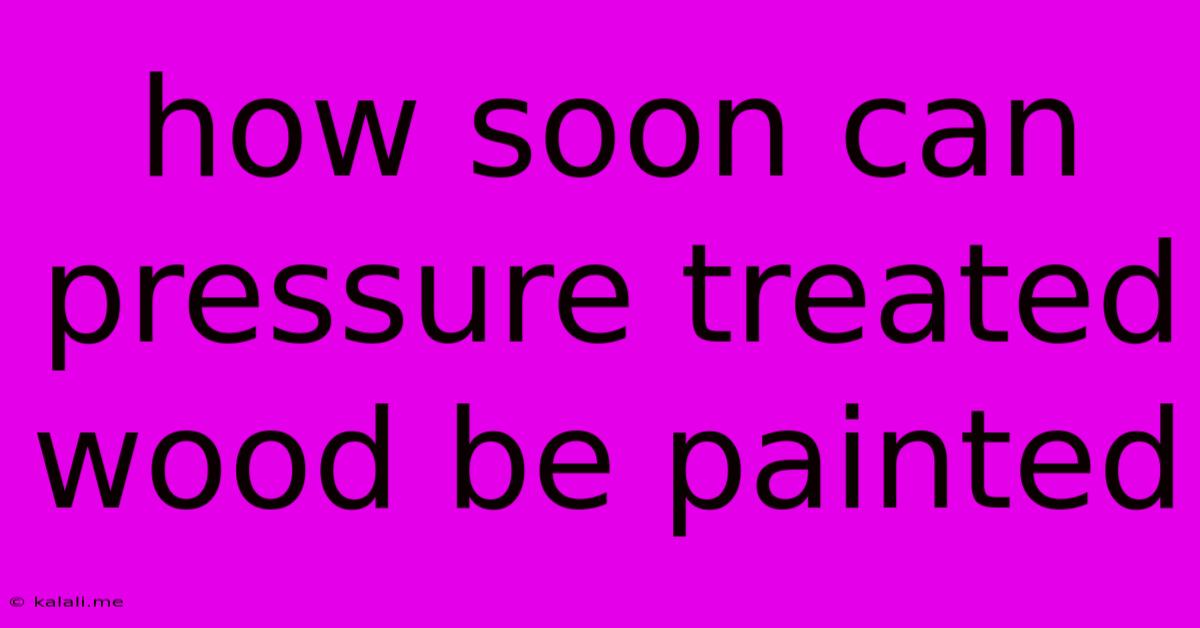How Soon Can Pressure Treated Wood Be Painted
Kalali
Jun 01, 2025 · 3 min read

Table of Contents
How Soon Can Pressure Treated Wood Be Painted? A Complete Guide
Meta Description: Learn the optimal time to paint pressure-treated wood for a long-lasting, beautiful finish. Discover the factors influencing drying time and best practices for painting to avoid common problems.
Pressure-treated wood is a popular choice for outdoor projects due to its durability and resistance to rot and insects. However, before you can enjoy its aesthetic appeal, you need to paint it. But the question remains: how soon can you paint pressure-treated wood after installation? The answer isn't a simple number of days; it depends on several crucial factors. This guide will walk you through everything you need to know to ensure a successful paint job.
Understanding the Drying Process
The key to painting pressure-treated wood successfully lies in understanding how the wood dries. The treatment process itself introduces chemicals that need time to cure and fully integrate into the wood fibers. This process takes longer than simply letting surface moisture evaporate. Rushing the painting process can lead to several problems, including:
- Peeling paint: The chemicals within the wood can react with the paint, causing it to peel or blister.
- Poor adhesion: A damp surface prevents the paint from properly adhering to the wood, leading to a short-lived finish.
- Mold and mildew growth: Moisture trapped beneath the paint provides the perfect breeding ground for mold and mildew.
Factors Affecting Drying Time
Several factors influence how long pressure-treated wood needs to dry before painting:
- Type of treatment: Different treatment methods use varying chemicals and concentrations, affecting drying times. Some treatments dry faster than others.
- Wood species: Different wood species absorb and release moisture at different rates. Denser woods tend to dry slower.
- Wood thickness: Thicker pieces of wood naturally take longer to dry completely.
- Climate: Humidity and temperature significantly impact drying time. High humidity slows the drying process, while warmer temperatures accelerate it.
- Wood preparation: Proper preparation, including sanding and cleaning, can help accelerate drying by removing surface debris and allowing for better air circulation.
The General Rule of Thumb and Beyond
While there's no single magic number, a general rule of thumb is to wait at least 2-3 months before painting pressure-treated wood. This allows ample time for the chemicals to cure and the wood to dry sufficiently. However, this is just a guideline. In hotter, drier climates, you might be able to paint sooner. Conversely, in humid climates, you may need to wait longer.
For accurate assessment, use a moisture meter. This tool will measure the moisture content of the wood. Aim for a moisture content of around 12-15% before painting. This ensures the wood is dry enough to prevent issues.
Preparing Your Pressure-Treated Wood for Painting
Even after sufficient drying time, proper preparation is crucial for a successful paint job:
- Clean the surface: Remove any dirt, debris, or mildew with a stiff brush and a cleaning solution.
- Sand the surface (optional): Light sanding can create a smoother surface for better paint adhesion.
- Prime the wood (recommended): A quality primer will help seal the wood and improve paint adhesion, especially on pressure-treated lumber.
Choosing the Right Paint
Selecting the right paint is just as important as timing. Look for exterior-grade paints formulated for wood, and ideally, ones specifically designed for pressure-treated lumber. These paints are designed to withstand the elements and are less likely to react negatively with the treatment chemicals.
Conclusion
Painting pressure-treated wood requires patience and preparation. While a few months is a good general rule, using a moisture meter and carefully considering environmental factors is key to achieving the best results. By following these guidelines, you can ensure a long-lasting and beautiful finish on your outdoor projects. Remember, taking the time to properly prepare your wood will save you time and effort in the long run.
Latest Posts
Latest Posts
-
How Do You Know If A Transmission Is Slipping
Jun 02, 2025
-
Can You Plant Plastic Containers In The Ground
Jun 02, 2025
-
How To Insulate Pipes In A Crawl Space
Jun 02, 2025
-
How Much Is One Green Onion
Jun 02, 2025
-
Where Do You Get The Exp Share In Emerald
Jun 02, 2025
Related Post
Thank you for visiting our website which covers about How Soon Can Pressure Treated Wood Be Painted . We hope the information provided has been useful to you. Feel free to contact us if you have any questions or need further assistance. See you next time and don't miss to bookmark.